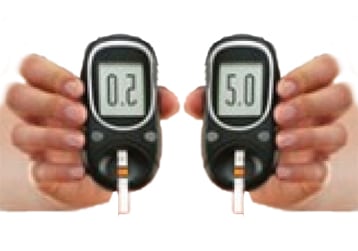Blood glucose monitoring is an essential element of an effective diabetes self-management pair. Often people wind up collecting data that can be difficult for them to understand. Discover the concept of testing in pairs and how it can help you better manage your diabetes.
- The term “testing in pairs” was originated by Dr. Bill Polonsky of the Behavioral Diabetes Institute in San Diego, California. It refers to the concept of taking two sets of blood glucose readings to tell a story about what is happening in your body. For example, taking your blood sugar readings before and after exercise lets you know the impact physical activity is having on your blood glucose levels.
 Monitoring in pairs helps give context to each number rather than a number that stands alone and involves speculation about why your blood sugar levels are high or low. You may want to take your blood glucose readings before and after a meal to determine how different foods impact your blood sugar levels. Always wait 2 hours after your first bite as the after meal reading to get an accurate number. You could also try taking your blood glucose readings before going to bed at night and then the next morning. If your blood sugar rises during that time it could indicate your liver is releasing excess glucose into your system as you sleep.
Monitoring in pairs helps give context to each number rather than a number that stands alone and involves speculation about why your blood sugar levels are high or low. You may want to take your blood glucose readings before and after a meal to determine how different foods impact your blood sugar levels. Always wait 2 hours after your first bite as the after meal reading to get an accurate number. You could also try taking your blood glucose readings before going to bed at night and then the next morning. If your blood sugar rises during that time it could indicate your liver is releasing excess glucose into your system as you sleep.- Testing in pairs helps you know more about the effects of the foods you eat. Knowing your blood sugar levels before and after a meal helps you determine if the choice of foods or your mealtime diabetes treatment should be adjusted. This information should be shared with your diabetes health care team to help them update your self-management plan.
- Make sure to always have plenty of diabetes supplies on-hand to test your blood glucose levels. Record the results and report them to your doctor during regular visits. Report unusual fluctuations to your doctor to address any problems that may require changing your current treatment plan.
- There is a situation when a single blood glucose reading has important value. A singular reading can identify hypoglycemia. If you feel jittery, weak, irritable, hungry, sweaty, shaky or dizzy, check your blood sugar levels to see if they are low. The idea of testing in pairs comes again when you check your blood sugar after the crisis has been averted by taking 15 grams of fast-acting carbohydrate such as 3-4 glucose tablets. The second test will determine how effective your treatment was.
- Often the number of pairs of blood glucose checks you do in a day is determined by your doctor’s advice and your health insurance coverage for diabetes supplies such as blood glucose testing trips. Testing in pairs can also determine the effectiveness of oral medications and insulin to ensure the dosage is correct. The optimal monitoring schedule is based on the individual patient’s situation. For example, those taking three oral drugs should monitor more often than people taking just one. People who take insulin should monitor their blood sugar levels more frequently than those taking oral medication. Patients taking fast-acting insulin should monitor more often than people who just take basal insulin.
- Lifestyle is often taken into consideration when a blood glucose monitoring schedule is determined. People who work irregular hours in shifts tend to have blood sugar patterns that fluctuate more than people who work regular hours. Those in high-stress jobs may also have more unstable blood sugar patterns. Discuss your lifestyle with your health care team to determine how often you should test your blood sugars.
Testing in pairs is a smart way to monitor your blood glucose levels. Make sure to keep accurate records and share them with your doctor to ensure your diabetes management plan is properly updated. Testing in pairs makes your blood glucose levels more meaningful to improve your overall treatment.






Leave A Comment